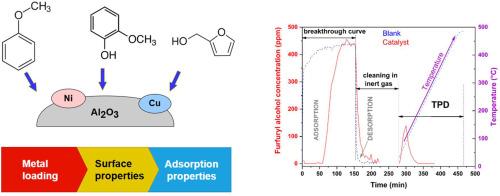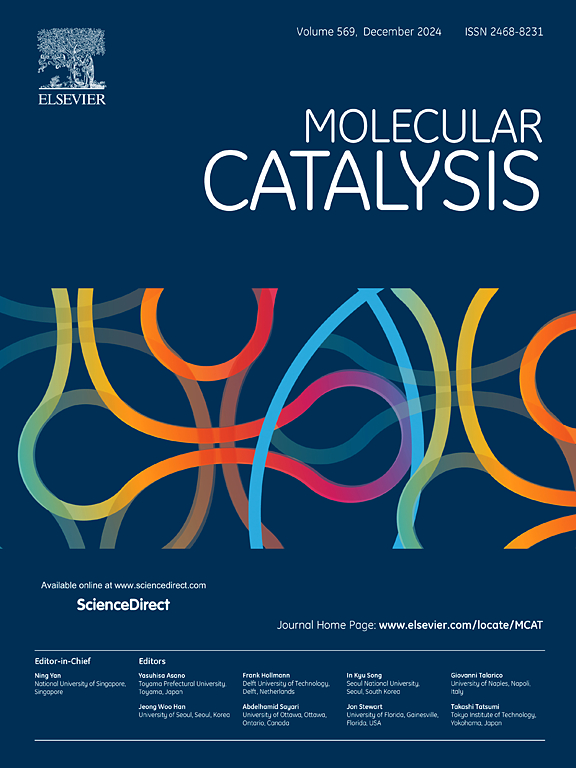Study of the adsorption of phenolics and furanics on the surface of Ni-Cu catalysts
IF 4.9
2区 化学
Q2 CHEMISTRY, PHYSICAL
引用次数: 0
Abstract
Paper provides a comprehensive study of Ni-Cu catalysts on alumina, focusing on the effects of metal loading, reduction temperatures, and bimetallic interactions on catalyst properties and adsorption behaviour of model organic molecules. Introduction of metal reduces catalyst surface area. Low Cu loadings promote formation of isolated Cu sites, higher result in large CuO clusters. Ni catalysts have composition consisting of a mixture of NiO, NiO-like, and spinel species and the surface is primarily covered by NiO. Bimetallic Ni-Cu catalysts reveal Cu enhanced hydrogenation ability and reducibility. Acidity, primarily originating from alumina, decreases with increasing metal loading, however increasing nickel loading induces new type of sites capable of decomposing NH₃. Reduced acidity limits anisole and guaiacol adsorption, while the presence of Cu provides additional adsorption sites for furfuryl alcohol. Organics exhibit distinct adsorption modes with following desorption and/or decomposition during thermal heating influenced by metal loading, catalyst composition and organics type. Incorporating Ni and Cu affects coke deposits: the most deposits are formed on alumina after guaiacol adsorption, while anisole leaves no carbonaceous residues. The study highlights the importance of reduction conditions on catalytic performance, advocating further research on adsorption under reaction-like conditions to understand the catalysts’ behaviour in practical applications.

镍铜催化剂表面吸附酚类和呋喃类的研究
本文对Ni-Cu催化剂在氧化铝上的应用进行了全面的研究,重点研究了金属负载、还原温度和双金属相互作用对催化剂性能和模型有机分子吸附行为的影响。金属的加入减少了催化剂的表面积。低Cu负载促进形成孤立的Cu位点,高Cu负载导致形成大的CuO簇。镍催化剂由NiO、类NiO和尖晶石混合组成,表面主要被NiO覆盖。双金属镍铜催化剂表现出Cu增强的加氢能力和还原性。酸度,主要来自氧化铝,随着金属负载的增加而降低,然而增加镍负载会产生能够分解NH₃的新型位点。降低的酸度限制了苯甲醚和愈创木酚的吸附,而铜的存在为糠醇提供了额外的吸附位点。受金属负载、催化剂组成和有机物类型的影响,有机物在加热过程中表现出不同的吸附模式,随后进行解吸和/或分解。镍和铜的加入对焦炭沉积有影响:愈创木酚吸附后在氧化铝上形成的沉积物最多,而苯甲醚不留下碳质残留物。该研究强调了还原条件对催化性能的重要性,提倡进一步研究类反应条件下的吸附,以了解催化剂在实际应用中的行为。
本文章由计算机程序翻译,如有差异,请以英文原文为准。
求助全文
约1分钟内获得全文
求助全文
来源期刊

Molecular Catalysis
Chemical Engineering-Process Chemistry and Technology
CiteScore
6.90
自引率
10.90%
发文量
700
审稿时长
40 days
期刊介绍:
Molecular Catalysis publishes full papers that are original, rigorous, and scholarly contributions examining the molecular and atomic aspects of catalytic activation and reaction mechanisms. The fields covered are:
Heterogeneous catalysis including immobilized molecular catalysts
Homogeneous catalysis including organocatalysis, organometallic catalysis and biocatalysis
Photo- and electrochemistry
Theoretical aspects of catalysis analyzed by computational methods
 求助内容:
求助内容: 应助结果提醒方式:
应助结果提醒方式:


